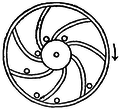|
English: Illustration from the 1911 Encyclopædia Britannica, article Perpetual Motion. Theoretical study of the perpetual wheel
We assume that the ball rolls and slips on the inner track of the wheel.
The various inventoried losses of this motor are :
Rolling friction losses ( Rrf ) of the ball on the inner track of the wheel and resulting from local deformation of the raceway under the weight of the ball,
Power losses due to sliding of the contact surfaces of the ball and raceway (ω' is greater than ω),
Loss of two ball bearings installed on the axis of the wheel.
Balance of forces
Balance of forces along y1 axis :
Balance of forces along x1 axis :
We have the following relationship between Rrf and R :
Then, it comes:
Expressing the following equalities :
It comes then :
In this formula, the following terms are known: F magnet, m, g, α and θ. α is the angle of the rolling friction.
The combined gravity and magnetic forces cause an unbalance of the rolling ball which is not compensated by an equal and opposite reaction force. The ball is forced to rotate and this rotation drives the main wheel by means of rolling friction force.
Due to violation of Newton's third law, there is creation of excess positive energy from potential energy supplied by static magnetic and gravitic fields.
Static potential energy is thus converted into kinetic energy by that perpetual wheel.
Calculation of drive torque
The drive torque is equal to Tdrive = Fresulting x r , soit:
Calculation of inlet power
Excepting parasitic movements linked to instantaneous instabilities of operation and taking the assumption of a constant angle theta, one can verify that the magnetic and gravity forces provide no power to mechanism. These two forces are involved only in maintaining an unstable state. Then:
Calculation of drive power
The sliding coefficient rslip of the ball on the inner race of the wheel is expressed by the following formula:
, then :
Let's calculate the drive power : Pdrive = Tdrive . ω'
with
Let's calculate the outlet power : Poutlet = Fresulting . R . ω
It has to be noted that:
and :
Calculation of COP (coefficient of performance)
Pnet outlet = Poutlet- Pwheel friction losses
Pwheel friction losses = 1% Poutlet and
Pnet outlet = 0,99 Poutlet
Calculation of COE (coefficient of energy)
Numerical application
r = 0,015 m - R = 0,15 m - g = 9,81 m/s² - θ = 30° - tan α = 0,001 - r slip = 10% - ω = 60 rpm = 6,2832 rd/s - B = 0,4 T - μ0 = 4 π 10-7 - μr = 1,0000004 - S = 0,01 x 0,01 = 10-4 m²
Fmagnet = 6,366 N
m = 0,014 kg
Fresulting = 5,442 N
Tdrive = 0,041 mN
Pdrive = 5,700 W
Poutlet = 5,130 W
P rolling losses = 0,570 W
P net outlet = 5,078 W
P wheel friction losses = 0,052 W
COP = ∞
COE = ∞ |


